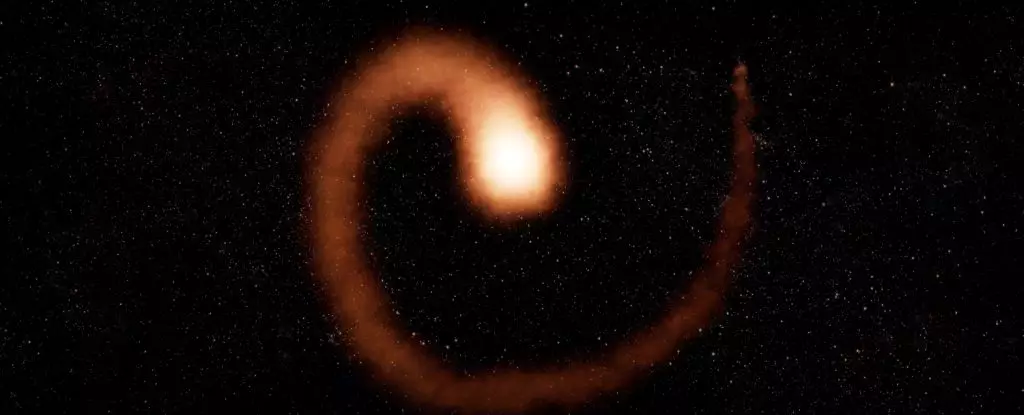Far beyond the reach of our solar system lies the mesmerizing Wolf-Rayet 104 (WR 104), a celestial wonder characterized by its stunning Pinwheel Nebula. Recent astronomical revelations have unveiled the secret choreography of this star system, comprising a dying giant star and its binary companion. The dramatic, predictable interactions between these stars shape the very fabric of the nebula into a breathtaking spiral formation, offering cosmic insights that are both illuminating and enigmatic. With the aid of advanced observational technology at the Keck Observatory, astronomers like Grant Hill have begun to depict a more intricate picture of celestial events that could inform our understanding of the life cycle of massive stars.
The Dance of Death: New Insights into Stellar Behavior
Wolf-Rayet stars, renowned for their immense size and luminosity, are nearing the apex of their stellar lives. With an age of merely 7 million years, WR 104 is anticipated to soon undergo a monumental death event in the form of a supernova. However, the recent findings have shifted the paradigm surrounding this celestial body, alleviating concerns over the hazardous ramifications of its explosive demise. This binary system provides a unique laboratory for studying the physics of stellar winds and mass ejection—key phenomena that occur before a star meets its end.
Hill’s observations have revealed an unexpected tilt in the stars’ orbital plane, diverging from assumptions that their poles aligned directly toward Earth. This means that should a gamma-ray burst accompany its supernova, potentially catastrophic radiation would be diverted away from our planet. Previous analyses had painted a picture of dire risk, labeling WR 104 as a “death star” due to its perceived perilous alignment; this new understanding transforms our narrative from one of looming catastrophe to one punctuated by the marvel of cosmic complexity.
The Perfectly Imperfect Cocktail of Stellar Winds
As WR 104 and its binary companion orbit each other in a circular path over the course of approximately 241.54 days, their powerful stellar winds collide and interact. The gravity of both these massive entities influences the dust they eject, sculpting it into the iconic spiral shape that characterizes the Pinwheel Nebula. The binary star, a hotter and even more massive OB star, contributes its winds, further complicating the chemical interactions at play. These collisions don’t just create stunning visuals; they provide an extraordinary insight into the processes that govern stellar evolution.
The intricate dance of the stars leads to the condensation of dust, further illuminated by the infrared telescopes that detect the heat emitted from these cosmic collisions. The beauty of such formations lies not only in their aesthetic appeal but also in the wealth of information they present us regarding the lifecycle and eventual death of massive stars. The study of WR 104 underlines an essential truth in astronomy: even in the predestined chaos, there exists an intricate order waiting to be revealed.
Mysteries Amidst Clarity: The Quandaries of Cosmic Alignment
Despite the newfound understanding of WR 104’s orientation and safety from gamma-ray bursts, an intriguing conundrum has emerged. While the binary stars’ poles do not threaten Earth, the visible spiral dust structure remains aligned with our vantage point. This apparent misalignment raises critical questions within astrophysics: What mechanisms govern the relationship between the dust shape and the critical orbital plane?
The observations not only enhance our comprehension of WR 104 but also expand our sense of cosmic curiosity. It is these intricate mysteries that lie at the heart of exploration and discovery, highlighting the continuous cycle of knowledge gain and inquiry. Each answer discovered seems to breathe life into additional questions—a testament to the dynamic nature of astronomical studies.
The Future of Stellar Investigation
The findings surrounding WR 104 signify a thrilling chapter in cosmic study, not just for the immediate insights they yield but for the potential they hold in deepening our understanding of the universe. As technology advances and observational methodologies evolve, we inch closer to untangling the myriad threads of stellar evolution, forming a deeper appreciation for the processes that sculpt our universe.
WR 104 represents a microcosm of the spectacular intricacy of celestial mechanics and their implications for life on Earth. The duality of beauty and danger encapsulated in this star system embodies the thrill of astronomical exploration. As we continue to engage with the cosmic narrative, we must embrace both the certainties and uncertainties that define it, comprehending that the very essence of research is rooted in the mysteries awaiting discovery among the stars.

